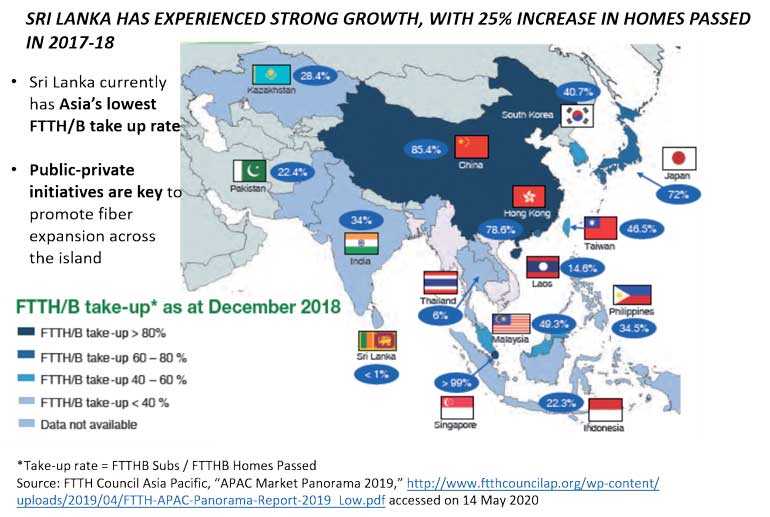Sunday Dec 15, 2024
Sunday Dec 15, 2024
Saturday, 6 June 2020 00:01 - - {{hitsCtrl.values.hits}}

 I left Sri Lanka 15 years ago as an emerging market telecom specialist on strategy and business development that took me to most parts of Asia. Within this period my home country’s economy has increased by 3.6-fold, from $ 24 b to $ 86 b today. However, it’s still stuck as a middle-income country and very heavily debt ridden.
I left Sri Lanka 15 years ago as an emerging market telecom specialist on strategy and business development that took me to most parts of Asia. Within this period my home country’s economy has increased by 3.6-fold, from $ 24 b to $ 86 b today. However, it’s still stuck as a middle-income country and very heavily debt ridden.
In contrast, my host country Malaysia’s economy only grew by 2.6x to reach $ 340 b and other neighbouring countries namely Singapore’s economy grew by 3x, India by 3.4x – but all with significantly less debt than Sri Lanka.
I always dreamt for our island nation to one day build a resilient $ 200 b economy and subsequently, catapult it into the first world. Japan and some countries in Europe have built a first world economy from the remnants of the second world war in just over two decades, so why can’t we?
Unfortunately, COVID-19 has dealt another blow to our economy while we’re still recovering from the gruesome Easter Sunday attack less than a year ago. The 49-day lockdown has resulted in a loss of $ 5 b of gross domestic product value or 6% of the GDP, shifting our economy into a de-growth for the first time since 2001, when our country was at the peak of the civil war.
Since the end of the civil war, there have been many attempts to kick start the economy, but external dollar-denominated debt, among other factors, stalled its developments. Since then, we keep borrowing more money to settle past commitments, the cycle continues as our debt continues to balloon.
So how do we untie this ‘Gordian Knot’ and get ourselves out of this economic mess? As the world recovers from COVID-19 and adjusting to a ‘new normal’, all known norms are being challenged and world is moving into new form of a digital yet self-aware era, here are five key areas Sri Lankan leaders could dive into.
1. Revitalise the sharing economy and digitisation
One key pillar in modern economic growth is the ‘sharing economy’. This means someone who work in a day job, spend additional few hours to provide peer to peer services via digital apps and/or marketplace to provide additional services to another party.
Predicted by Forbes to grow to $ 335 b in 2035 from just $ 15 b six years ago, the sharing economy has been a driver for growth to many modern economies. With the peer-to-peer model of the sharing economy, its contribution to a nation’s economic growth could double. Typically, both the provider and the user are individuals instead of businesses, allowing it to put cash straight into the pockets of everyday people. This is the best way to stimulate the GDP instead of our traditional methods of pushing for foreign direct investments, which wouldn’t exist in post-pandemic world and/or borrow at high cost to push infrastructure projects. In Malaysia, the digital economy represents 20% of the national economy.
In Sri Lanka, companies like Uber and PickMe deliver an average of 25,000 meals per day to local homes. This means 25,000 deliveries that are transacted and delivered within the hour by freelance riders who could come from any economic status or levels of education. In short, both sides of the service are now available for all. Therein lies the path to bridging the delta between the current $ 86 b economy and a $ 200 b economy by 2030. But I believe this is just a start.
This level of consumption is driven by the millennial and Gen Z generations. Over 25% of Sri Lanka’s total population is aged below 14 years, and over 40% of total population is in the age group 25-55 years. Their demand is simple – more data for less.
The demand will continue to grow post-pandemic. As many food businesses relying on foot traffic struggle for customers, there will naturally be an increase in adoption for digital platforms as the main channel to receive orders and payments. Plus, the convenience of home deliveries and self-pickups will be a no-brainer for both providers and end customers.
Growing the sharing economy requires supporting infrastructure in the form of fibre networks. A World Bank study finds that 10% increase in broadband penetration will result in a corresponding increase of 1.38 percentage points in national GDP growth. Simply put, the higher the broadband penetration, the faster we grow our economy.
2. Allocate funds to build digital infrastructure instead of highways
As road traffic eased up in the current pandemic, another type of traffic jammed up.
Our broadband connections.
New data shifts that telco companies have found during the lockdown:
n15% surge in per capita mobile data usage,
nchange in the usual pre-COVID peak time of 9-11 p.m. to daytime,
na shift in nature of use to increase in virtual private networks,
nincrease in video streaming and overall web traffic driven by work-from-home policies,
nsurge in e-commerce transactions.
To allow SMEs and corporations to continue their business and allow all to work from home, we need to build last mile fibre today, instead of roads and traditional infrastructure.
As an example, the UK Government has reconsidered a £ 28 b commitment for new roads, and switched that investment into broadband instead. It has planned an additional investment of £ 5 b – focused on 20% of the hardest-to-reach premises – to ensure that ‘gigabit-capable broadband’ is able to cover every home by the end of 2025. British Telecom has increased the target of fibre to the home (FTTH) and fibre to the business (FTTB) to 20 million by Q3 2020, mainly to support the usage during the pandemic.
While Sri Lanka’s fiber coverage is comparable to regional peers, commercial take up rate for FTTH/FTTB lags behind, as seen in the image.
Due to pandemic-induced economic shock, Sri Lanka’s sovereign credit rating has been downgraded to B- with a negative outlook. However, two key telecom assets remain unimpacted. Both Dialog Axiata PLC (AAA/Stable) and Sri Lanka Telecom PLC (AA+/Negative) maintained their ratings. They could play a pivotal role in building the next level of broadband access to connect cities and communities.
3. Build a resilient arrival eco system to revitalise the tourism sector ahead of others
Our tourism sector accounted for 12% and 4.3% of GDP in 2018 and 2019 respectively, a drop attributed to the Easter Sunday attack last year. With the pandemic, we can expect a further decline in 2020 tourism revenue. If the decline continues to 2021, it would paralyse our economy, so it’s paramount that an economic rebound plan be activated immediately.
One of the key elements to that, I believe, is the improvement on several factors on a tourist’s experience upon entering Sri Lanka. While other countries are laying out long, difficult processes, we may want to consider the following strategies to grab the tourist market again:
i.Faster turn-around for COVID-19 test results. This may be possible with the emergence of higher-quality research and better technology as it becomes available to governments. Following this, the period of quarantine may also be reduced, allowing tourists to enter the economic cycle as soon as possible.
ii.Quarantine centres must be in acceptable conditions. Many countries, including Malaysia, have taken advantage of the plunging hospitality industry by using five-star hotels as quarantine centres. Allowing our tourists to quarantine at more comfortable, hospitable accommodations would send a welcoming signal to travel junkies worldwide.
iii.Reducing contact with an end-to-end contactless boarding process. Multiple airlines have set in place boarding processes that no longer require human interactions. This is possible with the use of readily available inventions such as facial recognition technology and cashless payments. It’s time we implement this at our very own Bandaranaike.
Digitally savvy Gen Z and millennials are expected to be amongst the first international tourists, as they are comparatively less affected by COVID-19. Adopting these practices will allow us to attract them and be amongst the first international travel destinations to reopen during the pandemic.
4. Build the right ecosystem to attract relocating manufacturing outfits
Closure of borders and frictions in the global supply chain revealed the limits of globalisation. Now is the time to secure production contracts that needed to move from China, strengthen our manufacturing capacity and address shortages of urgently required goods.
In the short-term, the WHO has outlined three areas that require private sector support:
i.Keeping supply chains and logistics open so that drugs, vaccines and masks are available to deal with surging demand.
ii.Providing a flow of trusted information to employees. Companies should be as honest, transparent and as informed as possible.
iii.Engagement in specific sectors of health and pharma in critical research. This includes diagnostic tests, research in public health and prevention, and the development of new drugs and vaccines, therapeutics and drugs for patients who have already contracted COVID-19.
In the long term, we must proactively incentivise manufacturers relocating from China. As the most immediate advantage, our industrial wage costs in some technical categories are lower, or at least competitive to China. To succeed as an alternative manufacturing destination, we need reforms on trade, investment and improve ease of doing business. Measures may include issuance of tax exemptions and other incentives for manufacturing plants, promotion of low-cost, high-quality and locally-customised digital solutions for manufacturers.
5. Nurture SMEs and local economy
Small and Medium Enterprises (SMEs) are easy to destroy but hard to build. They are the bedrock of Sri Lanka’s economy, accounting for 75% of the total number of enterprises active in the country, providing 45% of employment and contributing 52% to its GDP.
The Government must, therefore, immediately consider innovative funding mechanisms such as issue of bonds for companies affected by COVID-19, or set up of a relief fund to alleviate its impact on SMEs and livelihoods of the people. In the long run, the Government must enact a structured funding and exit mechanisms for Sri Lanka’s investor landscape.
SMEs rarely have access to bank funding to scale and expand their businesses. This is because they are usually loss making at the time of investment, though they promise high returns in the future. Only a few private equity firms exist in Sri Lanka, and exit options for venture capital funds remain unattractive.
Established SMEs include family-held businesses in apparel, textile, construction, while start-ups include technology businesses led by Gen Z and millennials. According to the Asian Development Bank, the potential demand for capital by Sri Lanka’s established SMEs is estimated to be $ 0.5-$ 1 billion, and similar demand by start-ups is expected to reach ~$ 200 million by 2022.
There is a great bright future ahead of Sri Lanka, perhaps one rare chance offered in this century. Above five strategies will potentially help restart the domestic economy and eventually reduce our persistent balance of payment crisis. It may even allow the government to consider renegotiating 2017’s 99-year lease of Hambantota port and 15,000 acres of land around it to China. We have new hope and yet another chance in the direction of prosperity.
[The writer is Director of Strategy for edotco Group (a leading multi-country telecom tower company based out of Malaysia), an economist and one of the top experts in the global telecom infrastructure industry, highlights key opportunities the country should take advantage of post-pandemic.]